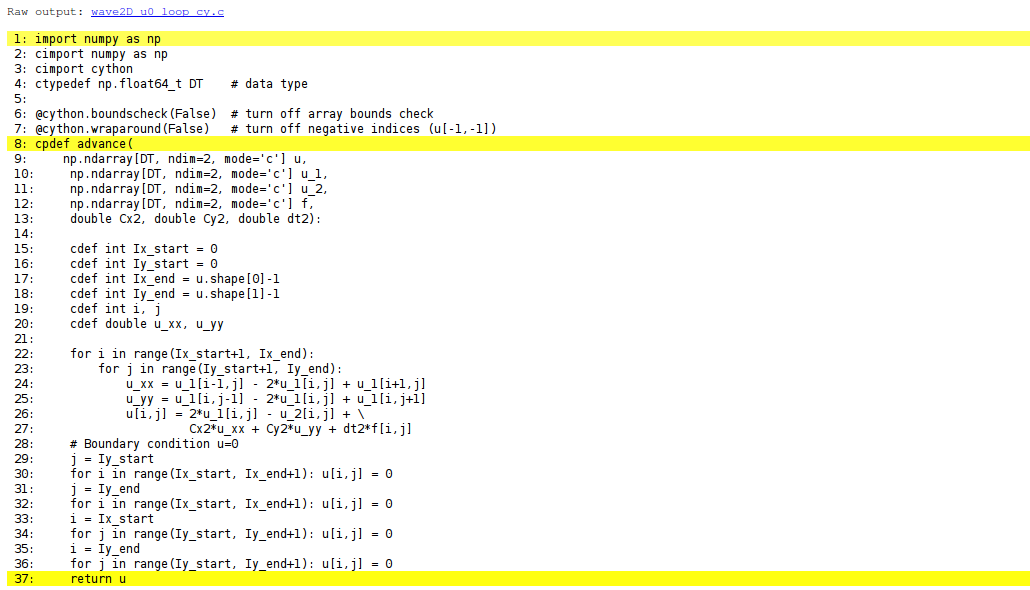
Migrating loops to Cython
Declaring variables and annotating the code
Cython version of the functions
Visual inspection of the C translation
Building the extension module
Calling the Cython function from Python
Migrating loops to Fortran
The Fortran subroutine
Building the Fortran module with f2py
How to avoid array copying
Efficiency of translating to Fortran
Migrating loops to C via Cython
The C code
The Cython interface file
Building the extension module
Migrating loops to C via f2py
The C code and the Fortran interface file
Building the extension module
Migrating loops to C++ via f2py
Pure Python code:
def advance_scalar(u, u_1, u_2, f, x, y, t,
n, Cx2, Cy2, dt2, D1=2, D2=1):
Ix = range(0, u.shape[0]); Iy = range(0, u.shape[1])
for i in Ix[1:-1]:
for j in Iy[1:-1]:
u_xx = u_1[i-1,j] - 2*u_1[i,j] + u_1[i+1,j]
u_yy = u_1[i,j-1] - 2*u_1[i,j] + u_1[i,j+1]
u[i,j] = D1*u_1[i,j] - D2*u_2[i,j] + \
Cx2*u_xx + Cy2*u_yy + dt2*f(x[i], y[j], t[n])
.pyx extension.function(a, b) \( \rightarrow \) cpdef function(int a, double b)v = 1.2 \( \rightarrow \) cdef double v = 1.2np.ndarray[np.float64_t, ndim=2, mode='c'] u
import numpy as np
cimport numpy as np
cimport cython
ctypedef np.float64_t DT # data type
@cython.boundscheck(False) # turn off array bounds check
@cython.wraparound(False) # turn off negative indices (u[-1,-1])
cpdef advance(
np.ndarray[DT, ndim=2, mode='c'] u,
np.ndarray[DT, ndim=2, mode='c'] u_1,
np.ndarray[DT, ndim=2, mode='c'] u_2,
np.ndarray[DT, ndim=2, mode='c'] f,
double Cx2, double Cy2, double dt2):
cdef int Nx, Ny, i, j
cdef double u_xx, u_yy
Nx = u.shape[0]-1
Ny = u.shape[1]-1
for i in xrange(1, Nx):
for j in xrange(1, Ny):
u_xx = u_1[i-1,j] - 2*u_1[i,j] + u_1[i+1,j]
u_yy = u_1[i,j-1] - 2*u_1[i,j] + u_1[i,j+1]
u[i,j] = 2*u_1[i,j] - u_2[i,j] + \
Cx2*u_xx + Cy2*u_yy + dt2*f[i,j]
Note: from now in we skip the code for setting boundary values
See how effective Cython can translate this code to C:
Terminal> cython -a wave2D_u0_loop_cy.pyx
Load wave2D_u0_loop_cy.html in a browser (white lines
indicate code that was successfully translated to pure C, while
yellow lines indicate code that is still in Python):

Can click on wave2D_u0_loop_cy.c to see the generated C code...
.so file) that can be
loaded as a standard Python modulesetup.py script to build the extension module
from distutils.core import setup
from distutils.extension import Extension
from Cython.Distutils import build_ext
cymodule = 'wave2D_u0_loop_cy'
setup(
name=cymodule
ext_modules=[Extension(cymodule, [cymodule + '.pyx'],)],
cmdclass={'build_ext': build_ext},
)
Terminal> python setup.py build_ext --inplace
import wave2D_u0_loop_cy
advance = wave2D_u0_loop_cy.advance
...
for n in It[1:-1: # time loop
f_a[:,:] = f(xv, yv, t[n]) # precompute, size as u
u = advance(u, u_1, u_2, f_a, x, y, t, Cx2, Cy2, dt2)
Efficiency:
numpy: 5.5numpy: 6advance function in pure Fortranf2py to generate C code for calling Fortran from Python
subroutine advance(u, u_1, u_2, f, Cx2, Cy2, dt2, Nx, Ny)
integer Nx, Ny
real*8 u(0:Nx,0:Ny), u_1(0:Nx,0:Ny), u_2(0:Nx,0:Ny)
real*8 f(0:Nx, 0:Ny), Cx2, Cy2, dt2
integer i, j
Cf2py intent(in, out) u
C Scheme at interior points
do j = 1, Ny-1
do i = 1, Nx-1
u(i,j) = 2*u_1(i,j) - u_2(i,j) +
& Cx2*(u_1(i-1,j) - 2*u_1(i,j) + u_1(i+1,j)) +
& Cy2*(u_1(i,j-1) - 2*u_1(i,j) + u_1(i,j+1)) +
& dt2*f(i,j)
end do
end do
Note: Cf2py comment declares u as input argument and return value
back to Python
Terminal> f2py -m wave2D_u0_loop_f77 -h wave2D_u0_loop_f77.pyf \
--overwrite-signature wave2D_u0_loop_f77.f
Terminal> f2py -c wave2D_u0_loop_f77.pyf --build-dir build_f77 \
-DF2PY_REPORT_ON_ARRAY_COPY=1 wave2D_u0_loop_f77.f
f2py changes the argument list (!)
>>> import wave2D_u0_loop_f77
>>> print wave2D_u0_loop_f77.__doc__
This module 'wave2D_u0_loop_f77' is auto-generated with f2py....
Functions:
u = advance(u,u_1,u_2,f,cx2,cy2,dt2,
nx=(shape(u,0)-1),ny=(shape(u,1)-1))
f2py!f2py takes a copy of a numpy (C) array and transposes it
when calling Fortrannumpy arrays with Fortran storage
order = 'Fortran' if version == 'f77' else 'C'
u = zeros((Nx+1,Ny+1), order=order)
u_1 = zeros((Nx+1,Ny+1), order=order)
u_2 = zeros((Nx+1,Ny+1), order=order)
Option -DF2PY_REPORT_ON_ARRAY_COPY=1 makes f2py write out
array copying:
Terminal> f2py -c wave2D_u0_loop_f77.pyf --build-dir build_f77 \
-DF2PY_REPORT_ON_ARRAY_COPY=1 wave2D_u0_loop_f77.f
numpy codeadvance function in pure Cnumpy arrays transferred to C are one-dimensional in C[i,j] indices to single indices
/* Translate (i,j) index to single array index */
#define idx(i,j) (i)*(Ny+1) + j
void advance(double* u, double* u_1, double* u_2, double* f,
double Cx2, double Cy2, double dt2,
int Nx, int Ny)
{
int i, j;
/* Scheme at interior points */
for (i=1; i<=Nx-1; i++) {
for (j=1; j<=Ny-1; j++) {
u[idx(i,j)] = 2*u_1[idx(i,j)] - u_2[idx(i,j)] +
Cx2*(u_1[idx(i-1,j)] - 2*u_1[idx(i,j)] + u_1[idx(i+1,j)]) +
Cy2*(u_1[idx(i,j-1)] - 2*u_1[idx(i,j)] + u_1[idx(i,j+1)]) +
dt2*f[idx(i,j)];
}
}
}
}
import numpy as np
cimport numpy as np
cimport cython
cdef extern from "wave2D_u0_loop_c.h":
void advance(double* u, double* u_1, double* u_2, double* f,
double Cx2, double Cy2, double dt2,
int Nx, int Ny)
@cython.boundscheck(False)
@cython.wraparound(False)
def advance_cwrap(
np.ndarray[double, ndim=2, mode='c'] u,
np.ndarray[double, ndim=2, mode='c'] u_1,
np.ndarray[double, ndim=2, mode='c'] u_2,
np.ndarray[double, ndim=2, mode='c'] f,
double Cx2, double Cy2, double dt2):
advance(&u[0,0], &u_1[0,0], &u_2[0,0], &f[0,0],
Cx2, Cy2, dt2,
u.shape[0]-1, u.shape[1]-1)
return u
Compile and link the extension module with a setup.py file:
from distutils.core import setup
from distutils.extension import Extension
from Cython.Distutils import build_ext
sources = ['wave2D_u0_loop_c.c', 'wave2D_u0_loop_c_cy.pyx']
module = 'wave2D_u0_loop_c_cy'
setup(
name=module,
ext_modules=[Extension(module, sources,
libraries=[], # C libs to link with
)],
cmdclass={'build_ext': build_ext},
)
Terminal> python setup.py build_ext --inplace
In Python:
import wave2D_u0_loop_c_cy
advance = wave2D_u0_loop_c_cy.advance_cwrap
...
f_a[:,:] = f(xv, yv, t[n])
u = advance(u, u_1, u_2, f_a, Cx2, Cy2, dt2)
advance function in pure Cf2py to generate C code for calling C from Pythonadvance as beforeadvance functionf2py generate the Fortran 90 moduleintent(c)):
subroutine advance(u, u_1, u_2, f, Cx2, Cy2, dt2, Nx, Ny)
Cf2py intent(c) advance
integer Nx, Ny, N
real*8 u(0:Nx,0:Ny), u_1(0:Nx,0:Ny), u_2(0:Nx,0:Ny)
real*8 f(0:Nx, 0:Ny), Cx2, Cy2, dt2
Cf2py intent(in, out) u
Cf2py intent(c) u, u_1, u_2, f, Cx2, Cy2, dt2, Nx, Ny
return
end
Generate Fortran 90 module (wave2D_u0_loop_c_f2py.pyf):
Terminal> f2py -m wave2D_u0_loop_c_f2py \
-h wave2D_u0_loop_c_f2py.pyf --overwrite-signature \
wave2D_u0_loop_c_f2py_signature.f
The compile and build step must list the C files:
Terminal> f2py -c wave2D_u0_loop_c_f2py.pyf \
--build-dir tmp_build_c \
-DF2PY_REPORT_ON_ARRAY_COPY=1 wave2D_u0_loop_c.c
numpy C arrays to C++ array classesf2pynumpy arrays to C API and let C translate numpy arrays
into C++ array classes